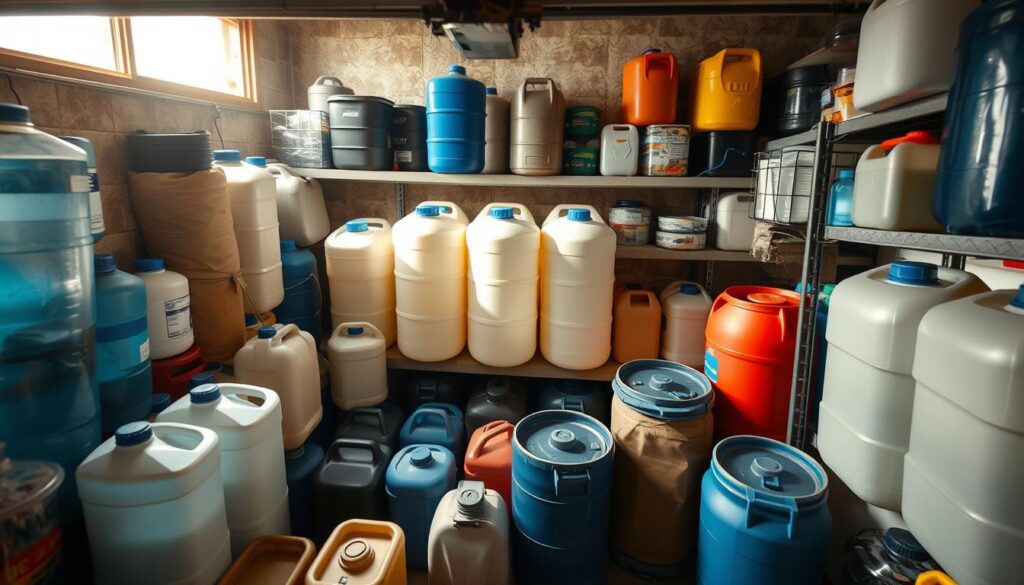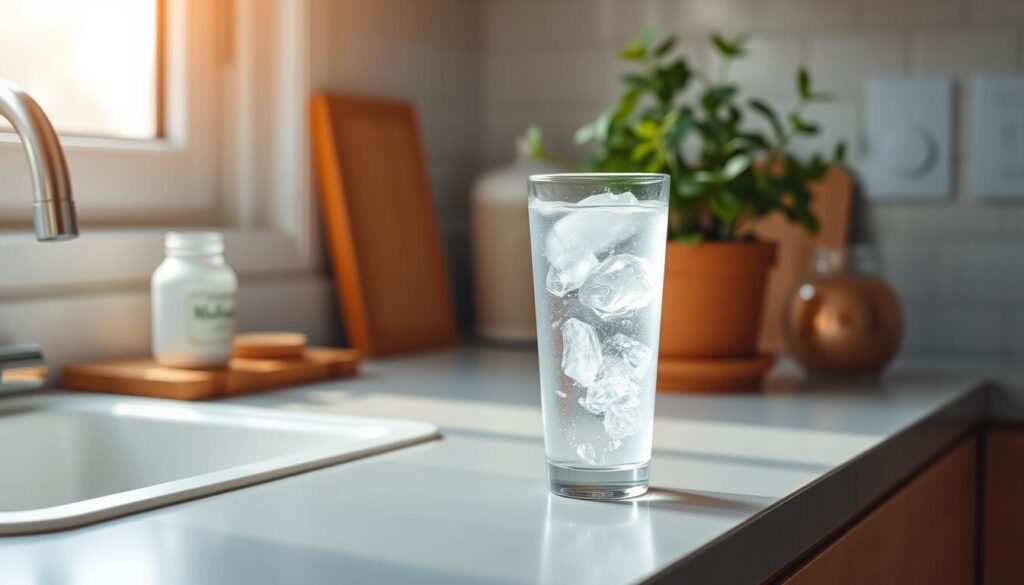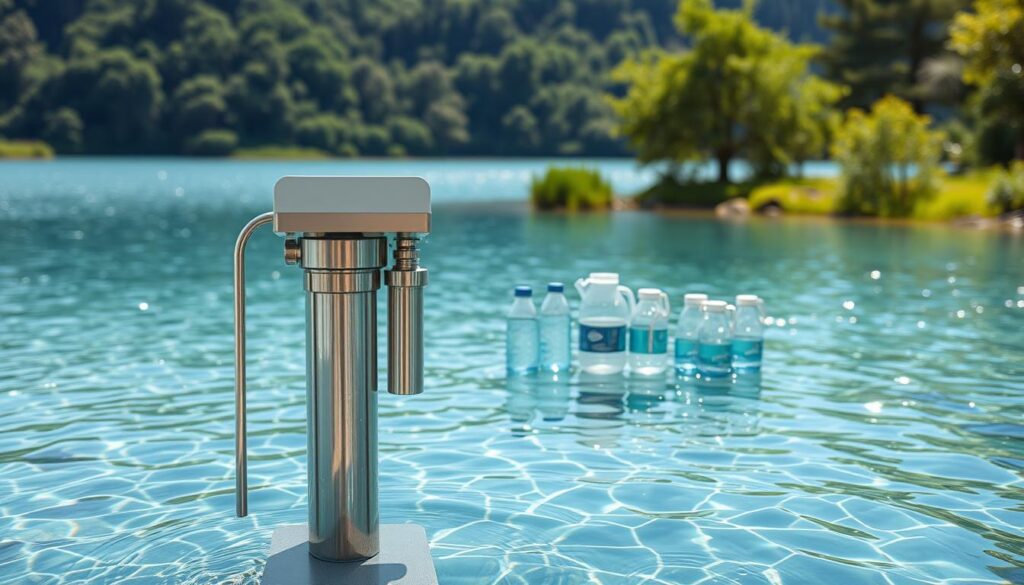Preparing for the unexpected is key in our lives. Having enough water is a top priority. I learned how important it is to have a good emergency water storage system.
The National Center for Emerging and Zoonotic Infectious Diseases (NCEZID) says we need at least 1 gallon of water per person per day. This rule has helped me prepare for emergencies.
Key Takeaways
- Store at least 1 gallon of water per person per day.
- Understand the importance of having an emergency water supply.
- Consider the needs of your family during emergencies.
- Follow guidelines from reputable sources like NCEZID.
- Regularly review and update your emergency water storage.
Understanding the Importance of Emergency Water Storage
Emergency water storage is key to being ready for disasters. Having a steady emergency water supply helps a lot when unexpected disasters hit.
The Portland Water Bureau says you should store at least 14 gallons of water per person. This can last about two weeks in an emergency. This shows how important a good water storage solution is.
Why Emergency Water Storage is Crucial
Storing water is important for many reasons. It gives you clean drinking water when regular supplies are cut off. It also keeps you clean and safe during disasters.
“In a disaster, having a reliable water supply can be the difference between life and death.”
Common Scenarios Requiring Extra Water Supply
There are many times when you need extra water. This includes natural disasters like wildfires, earthquakes, and hurricanes. It also includes man-made emergencies like water service interruptions.
| Emergency Scenario | Water Needs |
|---|---|
| Wildfires | For drinking, cooking, and firefighting |
| Earthquakes | For drinking, sanitation, and possible evacuation needs |
| Interruptions in Water Service | For all household needs until service is restored |
As shown in the table, different emergencies need different amounts and uses of water. Knowing the risks in your area helps plan your water storage solutions well.
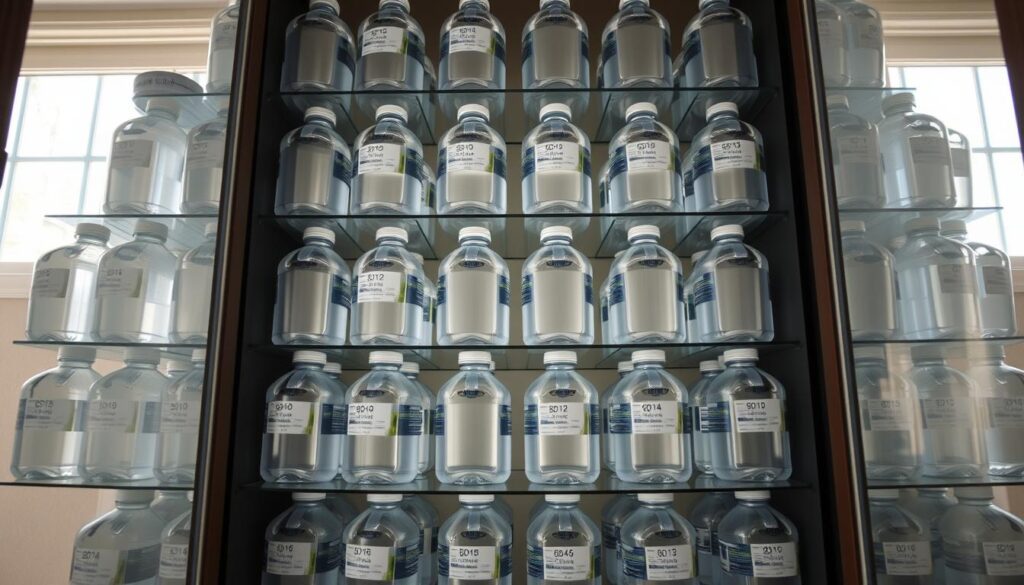
In conclusion, having a good emergency water storage plan is vital for disaster readiness. By understanding the need for extra water in various scenarios, you can prepare better.
Assessing My Water Needs
Figuring out how much water I need for emergencies is key. To do this right, I must think about a few important things. These things affect how much water I use every day.
Calculating Daily Water Consumption
The first thing to do is figure out how much water I use daily. A good rule of thumb is to have at least one gallon of water per person per day. This covers drinking, cooking, and staying clean.
But, this is just a starting point. My own situation matters a lot. For example, if it’s really hot where I live or I’m very active, I’ll need more water.
Factors Influencing Water Requirements
Many things can change how much water I need. For example, pregnant women, people who are sick, or those living in hot climates need more water.
- Climate: Hotter places need more water for staying hydrated.
- Physical Activity: People who are active need more water.
- Health Conditions: Some health issues mean you need to drink more water.
Preparing for Family and Pets
I also need to think about my family and pets. The NCEZID says to add extra water for pregnant women, people who are sick, pets, or if it’s very hot.
For families, we need to add up everyone’s water needs. For pets, we must think about how much water they drink and any extra they might need.
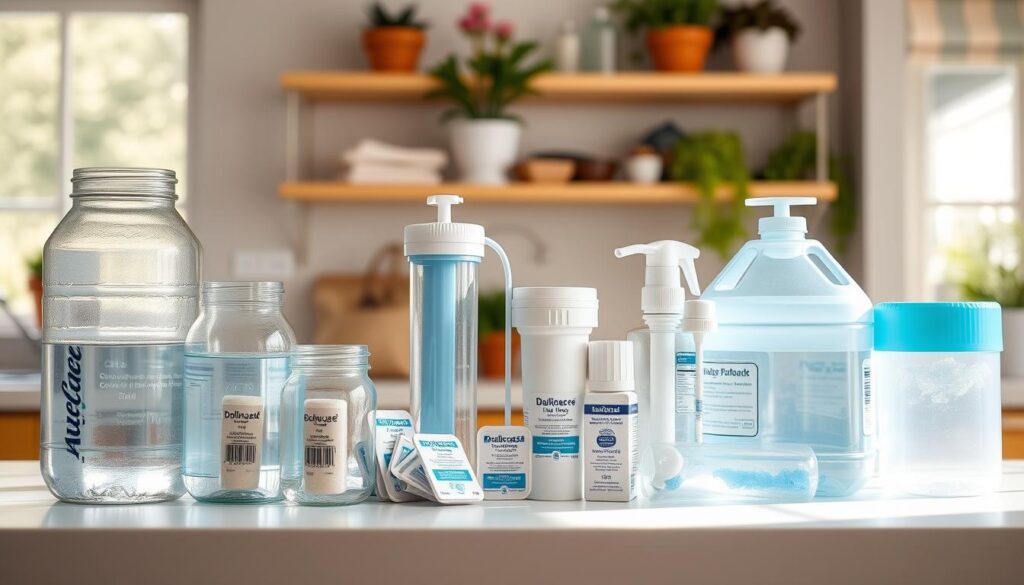
Choosing Appropriate Water Storage Containers
I always choose the right water storage containers for a reliable emergency water supply. The National Center for Emerging and Zoonotic Infectious Diseases (NCEZID) says to use FDA-approved food-grade containers. I follow this advice carefully.
Durability and safety are key when picking containers. They should be unbreakable and have a tight lid to stop leaks and keep water clean.
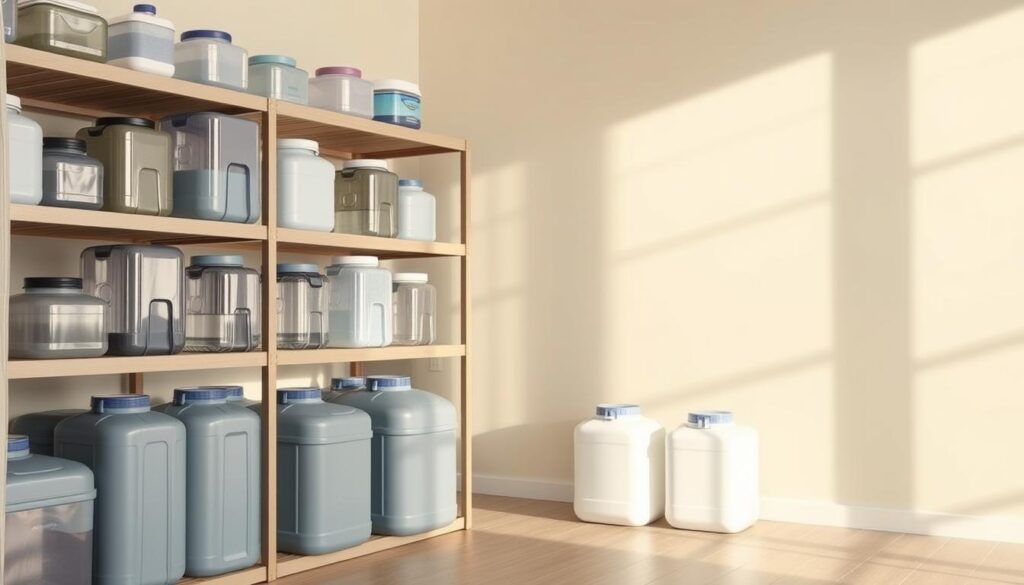
Types of Containers for Water Storage
There are many types of containers for storing water, like plastic bottles, stainless steel, and collapsible ones. Plastic bottles are cheap and easy to find. But, they must be made from food-grade material.
Stainless steel containers are tough and don’t rust, making them great for keeping water for a long time. They cost more than plastic, though.
Recommended Brands and Models
Brands like Reliance Products, Coleman, and Aquasafe are good for water storage containers. The CDC guidelines suggest using containers made for water storage.
I look at the material, size, and how easy it is to use when picking a brand or model.
Pros and Cons of Different Materials
Each material has its own benefits and drawbacks. Plastic is light and cheap but might have BPA, a chemical that can get into water. Stainless steel is strong and BPA-free but heavy and pricey.
- Plastic Containers: Pros – affordable, lightweight; Cons – might have BPA.
- Stainless Steel Containers: Pros – durable, BPA-free; Cons – heavy, expensive.
- Collapsible Containers: Pros – saves space, easy to carry; Cons – might not last as long.
By considering these points, I can pick the best water storage containers for my needs.
Finding the Best Location for Water Storage
Finding the right spot for emergency water storage is key. It keeps the water safe and easy to get to. The right spot can make your emergency plan work better.
Safe and Accessible Storage Spaces
Choose a spot that’s safe and easy to get to. It should be free from contaminants and simple for everyone to reach. This includes people with disabilities.
The NCEZID says to keep water in a cool, dark place. The temperature should be between 50°F – 70°F. Keep it away from sunlight and harmful substances. This helps keep the water good to drink.
“Water storage areas should be cool, dark, and free from any toxic substances.”
When looking for a spot, think about these things:
- Is it close to things that could make the water dirty?
- Is the temperature there steady?
- Is it easy to get to for upkeep and changing the water?
- Is it safe from damage?
Considerations for Indoor vs. Outdoor Storage
Indoor and outdoor storage each have good and bad points. Indoor storage is better because it keeps the temperature steady and protects from dirt. But, it needs enough room and might have dangers like chemicals or floods.
| Storage Location | Advantages | Disadvantages |
|---|---|---|
| Indoor Storage | Better temperature control, protected from contaminants | Limited space, possible indoor dangers |
| Outdoor Storage | More room, easier to get to | Can get too hot or cold, might get dirty |
Outdoor storage has more room but needs containers that can handle the weather. No matter where you choose, make sure the containers fit the place well.
In short, picking the best spot for water storage needs thought about safety, ease of access, and the environment. By using tips from the NCEZID and thinking about the good and bad of each spot, you can set up a good emergency water storage plan.
Filling My Storage Containers
Filling my water storage containers needs careful thought about the water source and quality. It’s key to make sure the water is safe and clean for a reliable emergency water supply.
Types of Water Sources I Utilize
I can fill my containers with tap water, rainwater, or water from rivers or lakes. But, the water quality from these sources can differ a lot.
Tap water is usually safe, but I should check with local water services for any advisories. Collecting rainwater is another good option, as long as the system is clean and free of contaminants.
Filtering and Purifying Water Before Storage
Before storing water, it must be clean and safe to drink. If the water source is questionable, I need to filter or purify it. The CDC advises using methods like boiling, water purification tablets, or filters with a 0.2 micron or smaller pore size.
It’s also important to sanitize the containers before filling. I can do this by rinsing them with a 1 teaspoon of unscented bleach per quart of water solution, then rinsing with clean water.
Tips for Efficient Filling Techniques
To fill my containers efficiently, I should follow a few tips. First, sanitize the containers before filling, as mentioned earlier. Then, fill them to the top to reduce air space, which can cause contamination or algae growth.
Using clean and sanitized filling equipment or hoses is also key to prevent contamination during filling. Labeling the containers with the date filled and the water type (if not tap water) helps keep my water storage solution organized.
- Use unopened, commercially bottled water for a straightforward solution.
- Sanitize containers before filling to prevent contamination.
- Minimize air space in containers to reduce the risk of algae or bacterial growth.
Maintaining My Emergency Water Supply
My emergency water supply needs regular checks to stay safe and usable. I follow guidelines for testing water quality and watch for signs it needs to be replaced.
Guidelines for Regularly Testing Stored Water
To keep my stored water quality high, I test it often. The Centers for Disease Control and Prevention (CDC) and other health groups suggest testing every six months. Here’s how I do it:
- Look for any signs of leakage, contamination, or damage to the storage containers.
- Check the water for visible contamination, like sediment, cloudiness, or unusual odors.
- Use water testing kits to check for bacteria or other harmful substances.
Regular testing ensures my water supply is safe to drink. It’s also important to clean and check the storage containers for damage.
Signs That My Water Needs to be Replaced
Even with proper storage, water can degrade over time. I watch for these signs that my stored water needs to be replaced:
- Unusual odors or tastes.
- Visible contamination or sediment.
- Cloudiness or discoloration.
The National Center for Emerging and Zoonotic Infectious Diseases (NCEZID) says to replace stored water every six months. But if I see any of these signs, I replace the water right away, no matter how long it’s been.
By following these guidelines and keeping an eye on my stored water, I make sure my emergency water supply is always ready.
Preparing My Water Supply for Emergencies
Preparing for emergencies means taking key steps. It’s important to make sure my water is safe and ready when I need it.
The Portland Water Bureau says being ready is key. This includes storing water and other emergency items. I’ll explain how I prepare my water supply, starting with making an inventory.
Creating an Inventory of My Water Supply
To manage my emergency water, I first make a detailed inventory. This includes:
- Recording the amount of water I have
- Noting when the water was stored
- Identifying where the water came from
- Documenting any treatment or purification methods used
This inventory helps me keep track of my water’s condition. It also tells me when it’s time to replace it.
Developing a Rotation Schedule for Usage
Creating a rotation schedule is key to keeping my water supply fresh. This means using the oldest water first. I do this by:
- Labeling containers with the storage date
- Using the oldest water first in non-emergency situations
- Regularly checking the condition of the stored water
This way, my emergency water stays reliable and fresh.
Storing Water with Other Emergency Supplies
I also store water with other emergency items. This includes food, first aid kits, and more. Storing them together makes my emergency kit complete and easy to find.
By following these steps and staying informed about emergency preparedness water storage and water storage guidelines, I’m ready for emergencies.
Educating My Family on Water Storage
Teaching my family about water storage is key to emergency preparedness. It’s not just about storing water. It’s also about making sure everyone knows why it’s important and how to use it in emergencies.
The Portland Water Bureau says it’s important to involve the community. By educating my family, we become more resilient and ready for emergencies.
Teaching Family Members About Emergency Preparedness
I start by explaining the basics of water storage and emergency risks. I talk about the need for a reliable water supply and how to use stored water in emergencies.
I also stress the importance of everyone’s involvement. This way, we all know our emergency plans and help with maintenance.
Assigning Roles and Responsibilities During Emergencies
It’s important to assign roles to each family member. For example, one person can check the water supply, while another maintains the containers.
To show who does what, I made a simple table:
| Task | Responsible Person |
|---|---|
| Checking water quality | John |
| Maintaining storage containers | Emily |
| Rotating water supply | Michael |
By educating my family and assigning roles, we’re ready for emergencies. This makes me confident in our ability to face unexpected situations.
Staying Updated on Water Storage Practices
To keep my emergency water supply ready, I make sure to stay current with water storage tips. I follow advice from trusted agencies and talk with local groups to get better at being prepared.
Guidelines from Reputable Agencies
I often visit the Federal Emergency Management Agency (FEMA) website for the latest on water storage. Their advice helps me improve my water storage plan and follow the best practices.
Engaging with Local Communities
Being part of local preparedness groups is also key for me. At community meetings and workshops, I learn new ways to store water and prepare for emergencies. This helps me update my emergency water plan.
By using official advice and local tips, I can keep my emergency water supply strong. This makes sure my family is safe and ready for any unexpected situation.
FAQ
How much water should I store for emergencies?
The NCEZID says to store at least 1 gallon of water per person per day. The Portland Water Bureau suggests 14 gallons per person.
What types of containers are suitable for water storage?
Use FDA-approved food-grade containers, as the NCEZID advises. These are safe for drinking water.
How often should I test and replace my stored water?
The NCEZID offers guidelines for testing and replacing water. I should regularly check my water for contamination or spoilage.
Can I use any water source to fill my storage containers?
Yes, you can use tap water, wells, or bottled water. But, make sure to filter and purify it first, as the NCEZID suggests.
How should I store my water supply to ensure it’s safe and accessible?
Store your water in a safe, accessible spot. Consider indoor or outdoor storage. The NCEZID has guidelines for keeping water safe.
What’s the best way to prepare my family for emergencies?
Teach your family about water storage and emergency plans. Explain the emergency plan and assign roles.
How can I stay updated on water storage practices and emergency preparedness?
Follow FEMA guidelines and join local preparedness groups. This way, you’ll know the latest on water storage and emergency prep.
What’s the importance of having a rotation schedule for my water supply?
A rotation schedule keeps your water fresh. Also, keep an inventory of your water and other emergency supplies.
How do I assess my family’s water needs during emergencies?
Calculate your daily water use and consider extra needs. The NCEZID advises on planning for family and pet needs.

